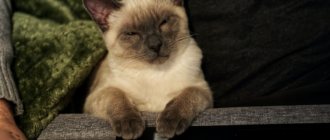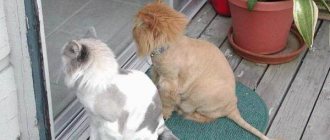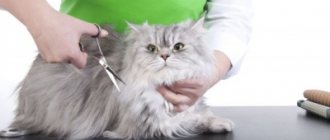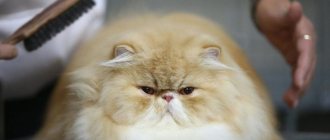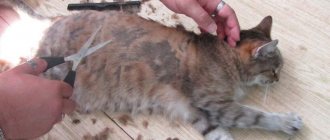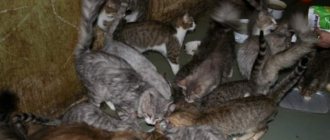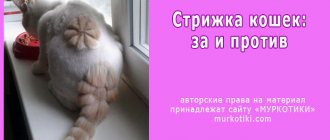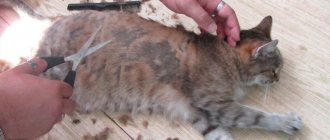Grooming a cat is a specific procedure that most owners prefer to entrust to a professional. However, it is not always possible to find a suitable master or pay him for the work. In some cases, you need to quickly cut your cat’s hair, and you don’t have time to go to a salon, so you have to think about how to carry out the procedure yourself. What are the features of grooming cats at home?
Why cut your cat's hair?
After clipping, the coat is easier to comb.
In fact, the procedure is quite popular and in demand in grooming salons. Yes, there are owners who bring their favorite furry dogs for a haircut in order to win at the exhibition, have an extravagant look and have cute photos for Instagram or social networks.
But there are also those who know that such hairstyles have many advantages for the health of their children. What are the advantages of a unique hygiene procedure?
- getting rid of tangles, which have become too numerous and can no longer be untangled with ordinary brushes;
- normalization of digestion: unsightly and hanging hairballs, disfiguring the cat, can cause blockage of the stomach and intestines if accidentally swallowed during another lick;
- order in the house: after a haircut, the wool does not lie everywhere and does not cause the owner to have bouts of quiet rage when, once again, black pants have turned into a shaggy hedgehog;
- easier combing;
- peace of mind between the cat and the person: you won’t have to tyrannize your pet and freak out from the daily tearing apart of tangled areas of fur;
- relief from suffering: in summer the animal will no longer suffer from the heat.
By the way, the presence of tangles is the cause of dermatological problems: the skin under them heats up more, creating favorable conditions for the development of pathogenic microflora. Frequent formation of “felt balls” indicates a metabolic disorder or vitamin deficiency and requires consultation with a specialist.
What to expect after a haircut
Despite the benefits of grooming for cats, especially those with thick, long hair, there are also negative consequences of this procedure. These points are mainly associated with changes in the structure of the coat. Thus, in tipped and colorpoint breeds, the coat that grows back after trimming becomes two or even four shades darker.
After being trimmed, cats' fur grows back slowly and may never reach its original length.
It is also important that after machine processing of cat fur:
- the fur coat may become thinner and shorter;
- the hairs in the first week after cutting (especially with a 1 mm length nozzle) will be hard and prickly;
- the likelihood of skin damage increases (during playing or scratching, after a long stay in the sun).
In my opinion, grooming a cat is a tedious procedure not only for the owner, but also for the animal. Therefore, it is better not to experiment with your pet unless unnecessary. Being the owner of both long-haired cats and medium-length purring cats, I have always limited myself to thorough combing. With proper care, machine treatment of a pet is not so necessary and is a last resort. And exotic lovers would do well to pay more attention to the psychological comfort of their pet. After all, curly haircuts take a lot of energy from a cat. For mobile or too independent “touchy people”, I would rather not change their image at all.
Manufacturers
The range of tools for grooming cats is quite extensive. The cost varies depending on the brand, purpose of the tool, and material.
Scissors should be easy to use and maintain.
Scissors from the brands Zolux (France), Ferplast (Italy), Trixie (Germany), Witte Rose Line (Germany), Geib Buttercut (USA) have proven themselves well in the household and professional spheres.
The tools from these brands are easy to use and suitable for home care.
Professional scissors are made of durable materials - stainless steel, with an additional titanium coating and therefore will last a long time without losing their qualities.
To cut or not to cut
It is important to understand that not all cats can and should be subjected to this procedure. So the following are a kind of contraindication:
- colorpoint and tipping colors - as the fur grows on the back and belly, it will become several tones darker than before cutting;
- disgusting character and violent temperament, when the animal does not give in to any persuasion. Of course, you can cut it under anesthesia, but in this case, evaluate all the possible risks associated with the administration of narcotic drugs: cardiac arrest, coma, failure of the liver and kidneys. As a last resort, sedatives and muscle relaxants are used instead of drugs, but only after approval of the appropriateness of their use by a specialist and under his clear guidance;
- Without an urgent need, there is no point in cutting short-haired cats - the heat does not particularly interfere with normal life activities, and they never have mats;
- Smooth-haired animals are cut only in extreme cases, for example, when they have been worn in oil paint and it is easier to shave the animal than to try to rub off the matted multi-colored wool.
Which cats should not be cut?
Owners of colorpoint and tipping cats are often interested in the question of whether their pets can be cut. This procedure will not affect their health in any way, but if the cat is a breeding cat, then it should be taken into account that after the haircut, the hair that grows back on the back and belly will be several tones darker.
Animals with a violent temperament that are not amenable to persuasion should not be cut unless absolutely necessary. The same applies to short-haired pets. They are not bothered by the heat, the fur does not tangle, so only if the cat gets very dirty, for example, with oil paint, is it easier to trim it than to wash it.
Tools and accessories
To groom a cat at home, you need to be patient and prepare the necessary equipment in advance. The less fuss and emotions there are, the calmer, faster and without incidents everything will go. So what might you need?
- assistant,
- special trimmer for cats (regular and for hard-to-reach places),
- rounded scissors with blunt ends, it is best to take surgical ones,
- In case of possible injury, prepare peroxide, cotton wool, and brilliant green.
The requirements for the trimmer are:
- quality and reliability;
- power of at least 45 watts. It is especially important to observe this point in relation to Persians, exotics and other owners of luxurious hair with thick undercoat;
- for other breeds, less powerful devices are also suitable;
- sharp blades that actually cut rather than tear out fur;
- the length of the blade is from 2 to 3 cm, otherwise you can accidentally injure the skin, especially if the haircut is carried out by an inexperienced user;
- the device must operate from the network, which guarantees its stable operation without interruption or loss of power;
- It is better if the motor is rotary rather than vibrating. Although this is not important, especially if the cat is cut from time to time.
Instead of an electric unit, you can use the most ordinary mechanical machine. It has a number of advantages:
- lower price,
- absence of unpleasant noise, and therefore the animal will be less nervous,
There are also some disadvantages: the hairstyle may turn out to be asymmetrical, and the process will be lengthy.
In principle, you can trim a cat’s hair at home with simple scissors, especially if you only need to cut off tangles or shape individual areas of the body.
Features of grooming
It is impossible to carry out such a procedure on your own and get an effective result without the help of an assistant. Before cutting, in addition to the necessary equipment, it is recommended to purchase a collar for the animal, specially designed to protect against its bites. In addition, it is worth stocking up on compounds that have disinfecting properties, for example, chlorhexidine or hydrogen peroxide. They may be needed in case of possible cuts.
Required Tools
Since cat fur is thick and fine in structure, using scissors and clippers on people would be impractical. To provide hairdressing services to animals, you should prepare specialized tools directly for grooming. Such a set should include:
- a comb in the form of a metal comb with a flat shape and a slicker brush;
- thinning scissors or their straight version with rounded blunt ends;
- a machine designed for shaving animals (including in hard-to-reach places), as well as corresponding knives, since it is almost impossible to trim a cat with scissors alone at home;
- a high-power hair dryer with a heat-off function;
- nail clipper for cats;
- accessories for fixation in case of active resistance of the cat.
When choosing a hair clipper, it is recommended to give preference to a model that operates from an electrical network, since during operation the batteries will be discharged and breaks will be required. This tool should be as quiet as possible.
An important element is a comfortable table. The person who will be doing the grooming must be able to approach the animal from any direction. It is best if the surfaces of this furniture are made of rubber, which will prevent the possibility of slipping and ensure the safety of the animal.
Preparing a cat for immobilization
There is a really workable option to immobilize a cat with a clothespin or a paper clip - essentially the same thing. The item is attached to the withers without causing pain or discomfort for the cat. Behavior is inhibited spontaneously and reactions are slowed down. The cat will better tolerate this procedure, provided that it is performed by a person close to him, or better yet, by the owner. Also, manipulation should be carried out only in case of urgent need, and not for fun. Most cats that were tried to be immobilized in this way experienced the action positively, without pain or fear. But no one is immune from the individual reaction of each individual cat.
First you need to prepare the cat for the procedure:
- If the pet is wearing a collar, it must be removed to provide free access to the cat's neck. If left on, it can create a suffocating feeling and your pet will become agitated.
- After this, you need to find the scruff. It is located on the outside of the cat's neck and looks like a loose fold. If it is difficult to feel the cat’s scruff, then it will not be easy to immobilize it. You should be extremely careful not to squeeze your cat's skin too hard.
- You need to grab the scruff of the neck with your hand and look at the pet’s reaction. If he feels completely relaxed, then he can quickly be immobilized. If the animal meows or tries to escape, then you need to try to immobilize it using another method.
You can determine that a cat is tense when he is not trying to escape by dilated pupils, intermittent breathing, and moving ears. If you grab it by the scruff of the neck closer to the ears, you can control the movement of the animal’s head. To avoid needing help when immobilizing a cat, it is better to watch a training video in advance. It's actually simple.
© shutterstock
How to carry out the procedure
The hair on a cat's head is usually not cut.
- The cat is fixed on its side by its hind and front legs.
- If the animal is overly aggressive, a collar is put on the animal to prevent it from biting.
- First they cut the tangles with scissors, and then take the clipper and continue working on the sides and back.
- The fur on the paws is removed last, if necessary at all.
- When working in the abdominal area, exercise maximum caution and carefully avoid the nipples and intimate area. It is better to cut the area around with scissors in advance so that all the delicate parts are clearly visible.
- The hairstyle is not done on the head; in extreme cases, it can be shaped using thinning scissors.
- The tail is cut at will and as the hairdresser's imagination allows.
It is important to carry out all manipulations as carefully as possible so as not to injure the animal. It is not always possible to completely trim an animal at once - do not be upset: even though the procedure will take place in several stages, but all participants in the “acting” will remain safe and sound.
After grooming, the cat should be washed and dried with a hairdryer. Although, to avoid unnecessary stress, you can simply wipe your pet with a damp cloth or suede cloth to remove cut and stuck hairs.
In the cool season, the trimmed miracle needs to be provided with a comfortable indoor microclimate without drafts and the possibility of hypothermia.
Tips for owners
Before grooming your cat at home, remember these important points:
- The nipples, genitals and anus should be trimmed very carefully, holding the cat firmly to the table.
- After a haircut, your pet may change the structure, color and length of its coat.
- You cannot trim your head, mustache or ear hair. If you want to give a neat look to the mane on your head, use thinning nails. Don't remove all the hair from the tail, mostly leave a tassel or whisk at the end.
- Stretch the cat's skin to avoid damaging it.
- You need to comb your cat after grooming with a special fur brush. Afterwards, wash your pet or wipe it with a damp cloth.
- Observe your pet's behavior for several days after the procedure. If you see any alarming changes, consult your veterinarian.
- It is necessary to cut your cat's hair no more than three times a year, as the fur grows back slowly.
Popular cat haircuts
There are exhibition and home haircuts. The following hairstyles are ideal for home use:
- lion - all hair is cut off except the head, the tip of the tail and the paws below the “knees” and “elbow”,
- puss in boots in this case leaves fur on the head, tail and the entire surface of the limbs,
- summer
Exhibition or model hairstyles are created by experienced groomers. There are many options for “laying”:
- continental,
- puma,
- harlequin,
- modern,
- the Dragon.
If your plans do not include a cat grooming or the animal stubbornly does not give in to the hairdresser’s onslaught, then you will have to monitor and care for the fur as usual:
- periodic combing,
- timely removal of matted hairs,
- the use of shampoos and conditioners that help soften and straighten the hairs.
Long-haired breeds must be given special products that dissolve tangles in the stomach or use ready-made food that already contains the necessary absorbable ingredients. And to prevent heat stroke, you will have to get an air conditioner.
Well, a video on the topic of how cats are cut in salons:
Where to cut a cat's hair in Moscow
To perform a hygienic or model haircut, you need to go to a beauty salon for animals. There are a large number of professional hairdressing salons and private hairdressers in Moscow. The advantage of grooming cats in a salon is that professional establishments are equipped with everything necessary to perform hairdressing and beauty services. But they have their drawbacks: a noisy road with many unfamiliar faces, a foreign environment, unusual procedures - this complex of unfavorable factors can affect the mental state of the cat.
The advantages of grooming cats at home are obvious: saving time and effort for the owner, as well as nerves for the pet. An animal at home behaves much calmer, due to the fact that everything around is native, there are no foreign smells and sounds. The only disadvantages include the inability of the master to carry professional equipment with him, but only hairdressing tools.
In the cabin
In the capital's hairdressing salons for animals, in addition to grooming, they provide a wide range of services to improve the appearance of your pet. Moscow salons are equipped with modern specialized equipment, tools and supplies for grooming of any complexity. But while a person who comes to an establishment will definitely appreciate the professionally designed and beautiful interior, then for many representatives of the feline breed any unfamiliar environment causes stress. Considering this circumstance, for particularly impressionable cats it is better to invite a specialist to your home.
Professional haircut at home
Grooming long-haired cats at home is especially in demand among residents of megacities due to constant employment. Specially trained groomers are able to find contact with any pet, making the procedure for trimming a cat at home quick and easy. The owner will only have to clean up the cut hair from the floor and console his mustachioed four-legged friend with something tasty.
How does haircut affect animals?
Is it possible to cut a cat's hair without causing any changes, and how will cutting it at home affect the pet's behavior?
Haircut significantly affects hair growth
Almost all long-haired breeds change coat color, becoming darker or lighter. It happens that haircut significantly affects the growth of fur, sometimes this process accelerates, and in some cases, on the contrary, it becomes slower, and in rare cases it stops growth completely.
Positive points
- Yes, a haircut makes life easier for a long-haired pet: it is easier for a cat to lick itself and wash its coat. In this case, the animal will not clog its stomach with swallowed wool.
- This means that hair removal paste is not needed and the family budget will not suffer.
- In summer, the animal suffers less from the heat, and in the winter months, apartment heating will warm the cat, no matter how short its hair is cut. The main thing is that there are no drafts in the rooms.
- The absence of fur on most of the purr's body gives owners rest. There is no need to comb your pet or fight fluffy debris in the apartment. After all, before the haircut, cat fluff flew around the house like poplar.
- No wool - no allergies. This is also an important aspect of the issue, especially for family allergy sufferers. You can safely continue to communicate with your four-legged family pet.
How to cut a cat's hair at home?
It is better to choose small and convenient scissors as the material at hand. If your pet has thick hair, then it is better to carry out the procedure using a clipper. But usually such devices buzz loudly and scare the animal. Therefore, when choosing a machine, choose the quietest copy. Ideally, this hygienic and aesthetic procedure should be carried out several times a year (4-5 months will be a break). Be sure to trim your pet before the summer heat begins. Animals with thick fur do not tolerate heat well. Make life easier for them and yourself. So, put aside your fear and start cutting hair. Prepare not only a tool (clipper, scissors, comb), but also medications in case of an accidental cut.
Not all cats will be happy with the procedure. Some cats will start screaming, running away and showing aggression at the sight of a clipper and scissors. If you have just such a disobedient pet living in your house, then involve another member of the household in the haircut. You will have to hold the animal's limbs and head with your hands, but do not tie up the unfortunate cat. The haircut usually starts from the sides, then goes to the back, and from there the clippers (scissors) are applied to the tummy. Especially large cleats of wool are initially cut off with scissors, otherwise the attachment for the clipper may break. Yes, and it will be more convenient. The belly should be trimmed carefully and delicately, especially in the nipple area.
To make it more convenient to work, use your fingers to stretch the skin of the cat. This will help you avoid unnecessary cuts. If you get to the paws and tail, but don't leave them completely bare. This way your cute pet will look a little like a lion cub. Of course, you don't need to shave your cat's head either. After grooming, be sure to bathe the animal and dry it with a hairdryer. And don't worry yourself, otherwise your trembling hands will harm the cat.
In this video you can clearly see how a cat is groomed, more professionally, already “with a full hand.” And in the second video, the haircut scene is more interesting, but, let’s say, less professional, although quite acceptable. The main thing here is to know your pet, and if he is restless and can scratch or even bite, then before grooming the cat you need to take measures for your own safety, namely, perform the procedure with an assistant, and approximately as shown in the first video.
Video: Grooming a cat at home
Recommendations from experts
The procedure for grooming domestic cats is a last resort; as a rule, it is resorted to due to the systematic formation of mats or the need for treatment based on medical indications. In most cases, animals with long hair undergo a similar process.
To prevent pets from getting tangled, it is recommended to comb them with special devices: a slicker brush and a furminator. In addition, animals need to be washed using high-quality products that help maintain the well-groomed condition of their “fur coat”. Such actions not only have a beneficial effect on the health of animals, but also relieve their owners from scraps of fur scattered throughout the house.
You should know that if someone in your household is allergic to a pet’s fur, cutting the pet’s fur will not help. This is explained by the fact that in this case the reaction of the immune system is caused directly by the skin secretions of the animal, as well as by its saliva preserved on the hair.
The coat of cats belonging to semi-longhaired breeds not only protects them from the cold, but also prevents overheating. This type is not inclined to form tangles and only needs regular bathing and combing. This applies to species such as Maine Coon, Norwegian and Siberian cats.
Persian breeds have thin and delicate fur, which after shearing is restored much easier than that of their counterparts. Persians have a very difficult time withstanding hot weather , so their coat is often shortened.
Why does a cat need a haircut?
Grooming domestic cats is an element of grooming, which is a set of procedures for caring for the skin of an animal. Since hairdressing services for purrs in our country are just gaining popularity, many owners of furry pets are wondering about the harmlessness of such a procedure. But zoologists assure that haircuts are not only allowed, but sometimes even beneficial for the health of cats. This cannot but please the owners of cats, especially those living in private houses and having access to the outdoors.
Grooming for long-haired cats is a physical necessity
Giving purr fur unusual shapes is becoming popular for two reasons - hygiene and originality. In the first case, a haircut is necessary for long-haired representatives of the cat family - Persian and Angora cats, Siberian and Norwegian forest cats. Otherwise, tangles and sticky pellets will form on pets’ fur coats, causing itching and irritation of the skin. In addition, without proper care, long and thick hair can cause gastrointestinal diseases and constipation.
To create an unusual image, the cat is given a model haircut, characterized by a variety of variations. In this case, the owner of the animal is guided not by the needs of the animal, but by his own ambitions and the desire to emphasize the cat’s individuality.
Other reasons to trim your furry pet's hair may be:
- seasonal increase in air temperature - it becomes difficult for a cat with a thick fur coat to tolerate heat of 35–40 degrees;
- increased work of the endocrine glands - a pet with such dysfunction needs careful hygiene and care;
- intensive molting - the purr still needs to be shown to a veterinarian to identify the cause of excessive hair loss;
- receding hairline in certain areas of the body - a haircut will not solve the problem, so the help of a veterinarian is required.
Despite the apparent benefits of hairdressing procedures for cats, especially those with thick, long hair, haircuts also have disadvantages. Since nature has provided for the natural conditioning of animal skin in all weather conditions (due to cavities in the hairs), unless absolutely necessary, it is better not to get carried away with such a fashionable trend. After all, after removing the fur, the cat’s body temperature also changes, which is why the animal becomes vulnerable to the slightest drafts or exposure to direct sunlight.
I believe that there is no need to cut cats when you can organize proper coat care, but if you can’t, then cut them. In this case, we will not act entirely correctly, but we will not allow the formation of tangles and, as a consequence, the appearance of parasites and skin diseases. As they say, let's choose the lesser evil.
S. Savchenko, veterinarian
https://vetdoc.in.ua/mozhno-li-strich-koshek-sovety-veterinara.htm
If we talk about the frequency of image changes for a domestic cat, then you need to take into account the breed of the animal and the age of the purr. On average, the fur of felines grows within 5 months from the moment of cutting. Therefore, it is best to carry out hairdressing procedures with your pet no more than two to three times a year. And remove tangles as matted wool appears.
Video: why groom cats
Reasons and frequency of haircuts
Cats need to be trimmed from time to time for several reasons. Most often, this activity should be carried out with animals that have long hair, due to its constant rolling into clumps, which cause numerous inconveniences. Cat haircuts can have different purposes:
- For hygiene purposes. In this case, the process is necessary due to the wool becoming tangled and matted. The animal may get too dirty, and the type of contamination will be paint products or certain building materials that cannot be removed with shampoo.
- In certain situations, the fur of very old or sick cats that are unable to take care of their “fur coat” is shortened. This procedure prevents the formation of hair balls in the stomach, which often cause intestinal blockage. It is also necessary in conditions of elevated air temperatures, when there is a risk of overheating of the pet.
- Due to prolonged molting. In this case, cutting will make keeping the animal much easier.
- For medicinal purposes. For certain diseases of cats, haircutting may be recommended by a veterinarian. Indications for such a procedure are usually infectious skin diseases, dermatitis, the appearance of various parasites, as well as hyperplasia of the sebaceous glands. Trimmed wool makes it possible to treat the skin with medications more effectively, and this significantly shortens the treatment process.
- Decorative haircuts. Such hairdressing services for pets are nothing more than a whim of their owners. With the help of a model haircut, owners try to emphasize the individuality of their pet and the characteristics of its character.
- Exhibition haircuts are designed to demonstrate the standards of their breed in animals.
Grooming a fluffy cat at home (step by step)
The order of manipulations when performing a self-grooming of a long-haired cat is as follows:
- Working tools must be disinfected before use.
- Then you should put “anti-scratch guards” on your pet’s claws (special silicone caps) or trim the claws. To trim, use special nippers, which are available in any pet store - “claw clippers”. Gently press down on the cat's paw and quickly cut off the claws. If the edges turn out uneven, you can trim them with a nail file.
- If your pet is unfamiliar with the procedure and you are not confident in your abilities, it is better to invite an assistant: he will hold the pet and distract him. To protect against bites, place a plastic Elizabethan collar on your cat.
- You can begin the procedure only after the cat is comfortably positioned on its side on the table surface and its paws are securely fixed.
- The haircut starts from the sides. There is no need to rush and be nervous, otherwise your anxiety will be transmitted to your pet and he will also begin to behave restlessly.
- The next stage is the back and stomach. Be careful when handling the stomach. There are mammary glands that can be easily injured. The trimmer movement can be carried out both in the direction of hair growth and in the opposite direction.
- If unnecessary hairs remain after using the trimmer, they can be removed with scissors.
- During the treatment process, try to slightly pull your pet's skin to minimize the risk of cuts. This is especially recommended when the work is done with scissors.
- The tail may be left uncut when trimming is performed for hygienic purposes. But, when the animal is preparing for an exhibition, you can cut it, leaving only a nice tassel at the tip of the tail. It is better to treat the ponytail with a trimmer.
- Upon completion of the haircut, the pet should be washed in warm water with the addition of zoo shampoo and dried. You can use a hairdryer set to a gentle setting with moderate heat.
It's up to you to choose the main tool for cutting your furry pet's hair. At the same time, keep in mind that the trimmer does not always do a good job, and after it you will still have to trim your hair with scissors. And working only with scissors is more dangerous for the cat and significantly lengthens the process, although it guarantees a more attractive appearance for your beauty.
The trimmer can only be used dry! Do not wet the fur under any circumstances if you are going to use an electric trimmer. On the contrary, when working with scissors, it is recommended to slightly moisten the wool, spray it with a spray bottle and distribute the moisture over the wool with a comb. This makes the cutting process easier.
It is not recommended to cut your hair too short, regardless of the breed. Firstly, a haircut that is too short carries the risk of injuring the animal’s skin during the procedure, and secondly, after the haircut, the pet’s normal thermoregulation must be maintained and it should not freeze.
Grooming with the help of a veterinarian
At home, cats often become, if not masters, then full members of the family. They perceive attempts to give medicine, trim claws or examine teeth negatively, running away, dodging or attacking the person. Similar behavior is observed when cutting hair. The animal hides in inaccessible places and attacks scissors or a machine.
In the veterinarian's office, your pet's behavior changes. Some are violent, but many resort to verbal resistance. That is, by continuing to howl and growl, the cat allows manipulations, such as injections and haircuts.
Hair styling is one of the services offered by animal clinics. It is quite expensive (comparable to minor, non-cavity surgery) and may involve anesthesia. The latter poses a risk to the life and health of the pet. On the Internet you can find reports of cats put into hibernation while their fur was being groomed, but which never woke up.
A professional machine, available in most offices, will quickly remove excess hair. In this case, the owner can use the tool himself while the veterinarian holds the cat - specialists are better at this task.
Distract or tire your pet
Do you want to know how to calm a cat down for a haircut? His favorite toys can help with this. Animals of both sexes may be attracted to pillows, soft toys, large spools of thread, and other objects. During the grooming process, these objects serve as “passive” entertainment - the pet does not chase them around the house, but clasps them with all its paws, simulating a fight.
The animal fixes the object it likes, paying little attention to the environment and the manipulations that are performed with it. The choice is yours to decide how to calm your cat before grooming.
In this state, the animal will allow you to trim not only its fur, but also its claws. The main thing is to monitor changes in your pet’s behavior. Eventually he may get tired of it and begin to show aggression towards the hairdresser.
Not wanting to affect the psyche, the owner can try to exhaust the pet in order to reduce the negative reaction to the haircut. For example, feed generously or have an active play session lasting at least 30 minutes.
After waiting 15-20 minutes after the cat lies down to rest, you can approach with scissors or a clipper. A tired animal may be more loyal to the procedure for some time. But this approach to cutting will require several stages - even with a clipper it will be difficult to cut off all the wool at once. During this time, the pet can also get used to the tool and begin to react less to it.
Immobilize or sedate
It is not recommended to use anesthesia and sleeping pills to create a hairstyle, but you can use more gentle drugs. Herbal-based products, like Kota Bayun, are suitable. But you need to start giving them at least a week before the procedure - the drug must accumulate in the body.
When choosing how to calm your cat before grooming at home, it will be more effective to use physical remedies instead of over-the-counter medications. By holding a cat by force, you suppress his will, thereby risking causing him depression or a nervous breakdown. Although such actions can radically stop aggression.
For cutting, it is recommended to hold the cat by the scruff of the neck. According to one version, the animal calms down, remembering how his mother endured him like this in childhood. The restrained pet is laid on its side and the hair is cut off - a job that, according to the Internet, can be done by one person. In reality, stupor when the scruff of the neck is grabbed does not always occur - the animal may continue to struggle.
A greater likelihood of success will be ensured by working in pairs: one person immobilizes the pet’s paws, lying on its side, the second person cuts the hair, additionally holding the body. But in this case, the cat often shows more aggression, offended by the “group attack.”
A compromise option is to cut your hair yourself using a bell collar. Plastic will prevent your pet from biting, and the absence of extra hands will make you less nervous. If the animal struggles too actively, you should stop working so as not to injure it with the cutting tool or damage the limbs.
It is better to ask a specialist for help or postpone the haircut to a time when the pet is calmer. Cats rarely agree to voluntarily give up their fur, even if it would benefit them.
You can try to calm the animal by moving it to a stressful hospital environment or by redirecting its attention to a toy.
In any case, it is better not to manipulate scissors and the machine alone. Since there is a chance that you will not hold the cat and it will get hurt trying to free itself from you and run away.
Do you know how to properly trim a cat's claws?
